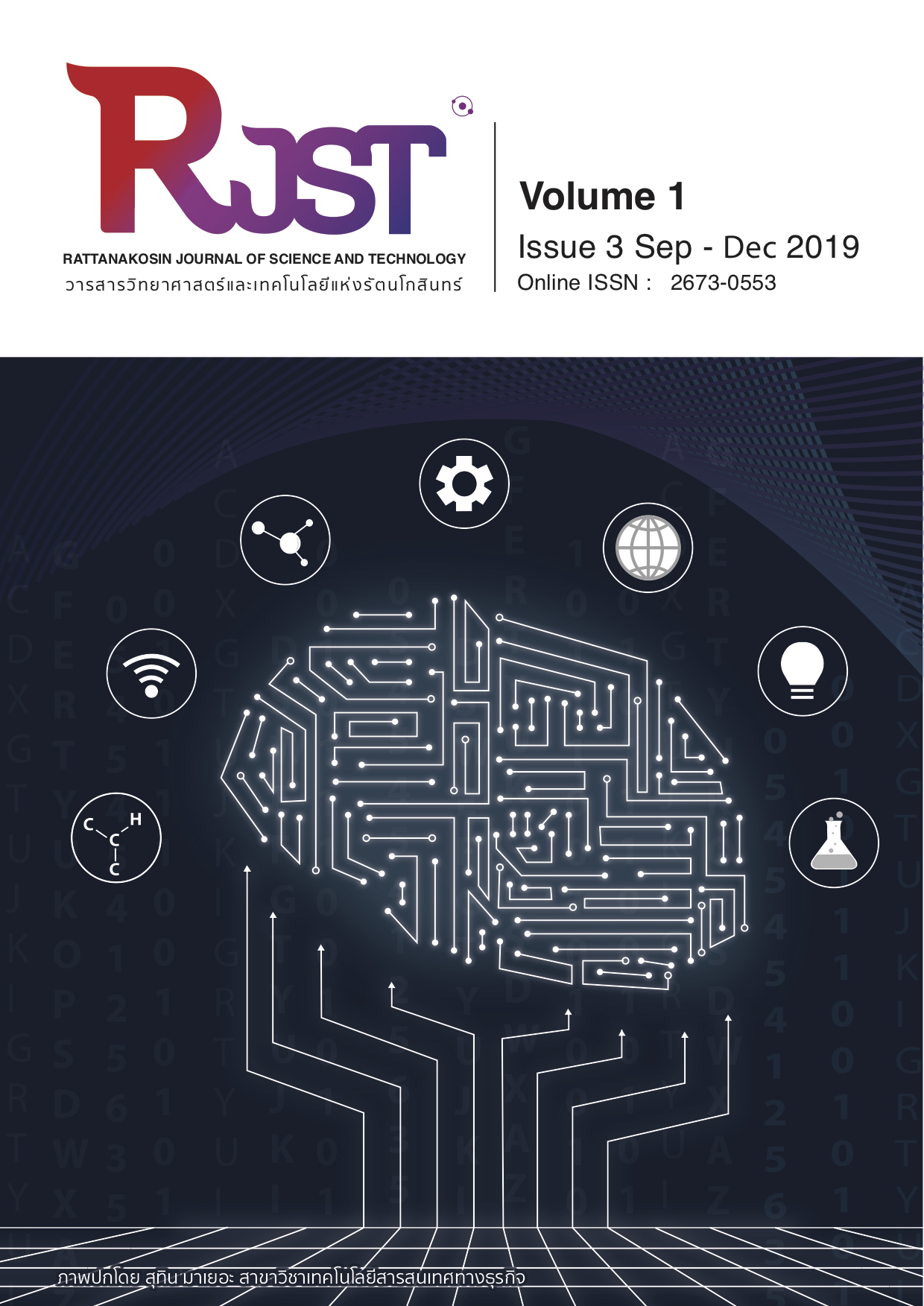การประยุกต์ใช้แผนภูมิหลายกิจกรรมในการปรับปรุงผลิตภาพ (กรณีศึกษาการก่อสร้างบ้านจัดสรร)
Main Article Content
บทคัดย่อ
งานวิจัยนี้มุ่งเน้นการใช้ทฤษฎีแผนภูมิหลายกิจกรรมในการปรับปรุงผลิตภาพ โดยศึกษา งานฝ้ายิปซั่มฉาบเรียบ งานปูพื้น ลามิเนต งานประตูไม้ งานปูกระเบื้อง งานทาสี จากนั้นศึกษาขั้นตอน และเวลาในการดำเนินงาน เพื่อหาสาเหตุของความล่าช้า ลดระยะเวลาในการทำงานแต่ละขั้นตอน และป้องกันแผนงานที่จะก่อให้เกิดความล่าช้า
สรุปได้ว่า งานปูพื้นลามิเนต งานปูกระเบื้องพื้น งานทาสี เป็นการทำงานที่ต่อเนื่องกัน ไม่มีเวลา รอคอย แนวทางในการเพิ่มอัตราผลผลิต คือ เพิ่มทรัพยากรแรงงานโดยยึดหลักขั้นตอนการทำงานแบบเดิม งานฝ้ายิปซั่มฉาบเรียบ ในส่วนของงานฉาบฝ้ายิปซั่มจะต้องรอติดแผ่นฝ้ายิปซั่มทำให้เสร็จก่อนถึงจะเริ่มฉาบฝ้าเพดานซึ่งเวลารอคอยนี้เป็นเวลาที่ตัดออกไม่ได้ จึงต้องปรับปรุงแผนงานใหม่คือ เพิ่มทรัพยากรในส่วนงานฉาบรอยต่อฝ้ายิปซั่มฉาบเรียบ ในขณะที่ติดตั้งแผ่นฝ้ายิปซั่มไม่ต้องเพิ่มทรัพยากร จากการที่ได้ทำการศึกษาปรับเปลี่ยนแผนงานใหม่นั้นสามารถลดเวลาลงได้คิดเป็นร้อยละ 41.40% งานติดตั้งประตูไม้เป็นการทำงานที่มีเวลารอคอยที่สูญเปล่าจากคนงาน B จึงได้มีการปรับปรุงแผนใหม่ขึ้นมา คือ เมื่อคนงาน A เจาะประตูใส่ลิ้นประตูแล้วจะ สามารถวัดระดับช่องเพลทรับลิ้นได้ให้คนงาน A วัดบอกระดับเพลทรับลิ้นให้คนงาน B เจาะรอไว้ในช่วง ที่คนงาน B กำลังติดตั้งตัวลูกบิด จากการที่ได้ทำการศึกษาปรับเปลี่ยนแผนงานใหม่นั้นสามารถลดเวลาลงได้คิดเป็นร้อยละ 18.53% ผลการศึกษาสามารถเป็นแนวทางในการนำเสนอ การใช้แผนภูมิกิจกรรมในการปรับปรุงผลิตภาพ บันทึกข้อมูลหน้างาน การจับเวลา เพื่อให้เห็นภาพที่ชัดเจนยิ่งขึ้น
Article Details
ข้อความภายในบทความที่ตีพิมพ์ในวารสารทั้งหมด รวมถึงรูปภาพประกอบ ตาราง เป็นลิขสิทธิ์ของมหาวิทยาลัยเทคโนโลยีราชมงคลรัตนโกสินทร์ การนำเนื้อหา ข้อความหรือข้อคิดเห็น รูปภาพ ตาราง ของบทความไปจัดพิมพ์เผยแพร่ในรูปแบบต่าง ๆ เพื่อใช้ประโยชน์ในเชิงพาณิชย์ ต้องได้รับอนุญาตจากกองบรรณาธิการวารสารอย่างเป็นลายลักษณ์อักษร
มหาวิทยาลัยฯ อนุญาตให้สามารถนำไฟล์บทความไปใช้ประโยชน์และเผยแพร่ต่อได้ โดยต้องแสดงที่มาจากวารสารและไม่ใช้เพื่อการค้า
ข้อความที่ปรากฏในบทความในวารสารเป็นความคิดเห็นส่วนตัวของผู้เขียนแต่ละท่านไม่เกี่ยวข้องกับราชวิทยาลัยจุฬาภรณ์ และบุคลากร คณาจารย์ท่านอื่น ๆ ในมหาวิทยาลัยฯแต่อย่างใด ความรับผิดชอบองค์ประกอบทั้งหมดของบทความแต่ละเรื่องเป็นของผู้เขียนแต่ละท่าน หากมีความผิดพลาดใด ๆ ผู้เขียนแต่ละท่านจะรับผิดชอบบทความของตนเอง ตลอดจนความรับผิดชอบด้านเนื้อหาและการตรวจร่างบทความเป็นของผู้เขียน ไม่เกี่ยวข้องกับกองบรรณาธิการ
เอกสารอ้างอิง
[2] รณรงค์ กระจ่างยศ. 2559. เทคนิคการควบคุมงานก่อสร้าง. มหาวิทยาลัยเทคโนโลยีราชมงคลรัตนโกสินทร์, นครปฐม
[3] สวลักษณ์ เชื้อสุวรรณ์, (2560), การศึกษาปัจจัยที่เป็นผลกระทบต่อการลดลงของผลิตภาพแรงงานก่อสร้าง. วิทยานิพนธ์ปริญญาโท มหาวิทยาลัยศิลปากร, นครปฐม.
[4] สุนันท์ มนต์แก้ว, และธวัชชัย นวเลิศปัญญา, (2559), การศึกษาผลผลิตของงานเสาเข็มเจาะระบบแห้ง, วิทยานิพนธ์ปริญญาตรี, มหาวิทยาลัยเทคโนโลยีรางมงคลพระนคร, กรุงเทพฯ.
[5] อรรถพล จันดาคูณ, (2561), การเพิ่มผลผลิตในงานก่อสร้างโดยการประยุกต์ใช้หลักออร์กอนอมิคส์ : กรณีศึกษาการตัดเหล็กปลอกเสริมคอนกรีต, วิทยานิพนธ์ปริญญาโท มหาวิทยาลัยอุบลราชธานี, อุบลราชธานี.
[6] ศศิพร สายสุทธิ์, (2561), การเพิ่มประสิทธิภาพการทำงานของธุรกิจก่อสร้างและการวิเคราะห์ธุรกิจเพื่อการวางแผนพัฒนาองค์กรเพื่อรองรับการแข่งขันในอนาคต กรณีศึกษา : ห้างหุ้นส่วนจำกัดพรพิมลฮาร์ตแวร์, วิทยานิพนธ์ปริญญาโท, มหาวิทยาลัยหอการค้าไทย, กรุงเทพฯ.
[7] อาณัติ กิตติกุลเมธี, (2560), กรณีศึกษาผลิตภาพแรงงานของกิจกรรมการตัดหัวเสาเข็มเจาะฐานราก เสาและ พื้น ในอาคารคอนกรีตเสริมเหล็ก, วิทยานิพนธ์ปริญญาโท, มหาวิทยาลัยเทคโนโลยีพระจอมเกล้าธนบุรี, กรุงเทพฯ.
[8] Sneha Jamadagni, (2016), Productivity Improvement in Construction Industry.


